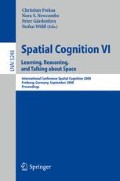Abstract
Two experiments were conducted to assess whether the orientation of the body at the time of test affects the efficiency with which people reason about spatial relations that are encoded in memory through symbolic media. Experiment 1 used depicted spatial layouts while Experiment 2 used described environments. In contrast to previous studies with directly-experienced spatial layouts, the present experiments revealed no sensorimotor influences on performance. Differences in reasoning about immediate and non-immediate environments are thus discussed. Furthermore, the same patterns of findings (i.e., normal alignment effects) were observed in the two experiments supporting the idea of functional equivalence of spatial representations derived from different modalities.
The presented experiments have been conducted as a part of an undergraduate thesis by Stephanie Pantelidou.
Access this chapter
Tax calculation will be finalised at checkout
Purchases are for personal use only
Preview
Unable to display preview. Download preview PDF.
References
Amorim, M.A., et al.: Updating an object’s orientation and location during nonvisual navigation: a comparison between two processing modes. Percept. Psychophys. 59(3), 404–418 (1997)
Farrell, M.J., Thomson, J.A.: On-Line Updating of Spatial Information Druing Locomotion Without Vision. J. Mot. Behav. 31(1), 39–53 (1999)
Loomis, J.M., et al.: Spatial updating of locations specified by 3-d sound and spatial language. J. Exp. Psychol. Learn. Mem. Cogn. 28(2), 335–345 (2002)
Rieser, J.J.: Access to knowledge of spatial structure at novel points of observation. J. Exp. Psychol. Learn. Mem. Cogn. 15(6), 1157–1165 (1989)
Presson, C.C., Montello, D.R.: Updating after rotational and translational body movements: coordinate structure of perspective space. Perception 23(12), 1447–1455 (1994)
Wang, R.F., Spelke, E.S.: Updating egocentric representations in human navigation. Cognition 77(3), 215–250 (2000)
May, M.: Imaginal perspective switches in remembered environments: transformation versus interference accounts. Cognit. Psychol. 48(2), 163–206 (2004)
Mou, W., et al.: Roles of egocentric and allocentric spatial representations in locomotion and reorientation. J. Exp. Psychol. Learn. Mem. Cogn. 32(6), 1274–1290 (2006)
Kelly, J.W., Avraamides, M.N., Loomis, J.M.: Sensorimotor alignment effects in the learning environment and in novel environments. J. Exp. Psychol. Learn. Mem. Cogn. 33(6), 1092–1107 (2007)
Mou, W., et al.: Allocentric and egocentric updating of spatial memories. J. Exp. Psychol. Learn. Mem. Cogn. 30(1), 142–157 (2004)
Mou, W., McNamara, T.P.: Intrinsic frames of reference in spatial memory. J. Exp. Psychol. Learn. Mem. Cogn. 28(1), 162–170 (2002)
Wang, R.F.: Between reality and imagination: when is spatial updating automatic? Percept Psychophys 66(1), 68–76 (2004)
Wang, R.F., Brockmole, J.R.: Human navigation in nested environments. J. Exp. Psychol. Learn. Mem. Cogn. 29(3), 398–404 (2003)
Avraamides, M.N., Kelly, J.W.: Multiple systems of spatial memory and action. Cogn. Process (2007)
Presson, C.C., Hazelrigg, M.D.: Building spatial representations through primary and secondary learning. J. Exp. Psychol. Learn. Mem. Cogn. 10(4), 716–722 (1984)
Avraamides, M.N.: Spatial updating of environments described in texts. Cognit. Psychol. 47(4), 402–431 (2003)
Avraamides, M.N., et al.: Functional equivalence of spatial representations derived from vision and language: evidence from allocentric judgments. J. Exp. Psychol. Learn. Mem. Cogn. 30(4), 804–814 (2004)
Klatzky, R.L., et al.: Encoding, learning, and spatial updating of multiple object locations specified by 3-D sound, spatial language, and vision. Exp. Brain. Res. 149(1), 48–61 (2003)
Klatzky, R.L., et al.: Learning directions of objects specified by vision, spatial audition, or auditory spatial language. Learn. Mem. 9(6), 364–367 (2002)
Mellet, E., et al.: Neural basis of mental scanning of a topographic representation built from a text. Cereb Cortex 12(12), 1322–1330 (2002)
Mellet, E., et al.: Neural correlates of topographic mental exploration: the impact of route versus survey perspective learning. Neuroimage 12(5), 588–600 (2000)
Taylor, H.A., Tversky, B.: Descriptions and depictions of environments. Mem. Cognit. 20(5), 483–496 (1992)
Denis, M., Zimmer, H.D.: Analog properties of cognitive maps constructed from verbal descriptions. Psychological Research 54(4), 286–298 (1992)
Waller, D., et al.: Orientation specificity and spatial updating of memories for layouts. J. Exp. Psychol. Learn. Mem. Cogn. 28(6), 1051–1063 (2002)
Harrison, A.M.: Reversal of the alignment effect: influence of visualization and spatial set size. In: Proceedings of the Annual Cognitive Science Meeting (2007)
Wildbur, D.J., Wilson, P.N.: Influences on the first-perspective alignment effect from text route descriptions. Q. J. Exp. Psychol. 61(5), 763–783 (2007)
Easton, R.D., Sholl, M.J.: Object-array structure, frames of reference, and retrieval of spatial knowledge. J. Exp. Psychol. Learn. Mem. Cogn. 21(2), 483–500 (1995)
Waller, D., Hodgson, E.: Transient and enduring spatial representations under disorientation and self-rotation. J. Exp. Psychol. Learn. Mem. Cogn. 32(4), 867–882 (2006)
Author information
Authors and Affiliations
Editor information
Rights and permissions
Copyright information
© 2008 Springer-Verlag Berlin Heidelberg
About this paper
Cite this paper
Avraamides, M.N., Pantelidou, S. (2008). Does Body Orientation Matter When Reasoning about Depicted or Described Scenes?. In: Freksa, C., Newcombe, N.S., Gärdenfors, P., Wölfl, S. (eds) Spatial Cognition VI. Learning, Reasoning, and Talking about Space. Spatial Cognition 2008. Lecture Notes in Computer Science(), vol 5248. Springer, Berlin, Heidelberg. https://doi.org/10.1007/978-3-540-87601-4_4
Download citation
DOI: https://doi.org/10.1007/978-3-540-87601-4_4
Publisher Name: Springer, Berlin, Heidelberg
Print ISBN: 978-3-540-87600-7
Online ISBN: 978-3-540-87601-4
eBook Packages: Computer ScienceComputer Science (R0)

